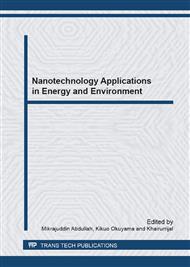[1]
J.D. Schiffman, C.L. Schauer, A review: Electrospinning of biopolymer nanofibers and their applications, Polym. Rev. 48 (2008) 317-352.
DOI: 10.1080/15583720802022182
Google Scholar
[2]
D. Li, Y.N. Xia, Electrospinning of nanofibers: Reinventing the wheel?, Adv. Mat. 16 (2004) 1151-1170.
DOI: 10.1002/adma.200400719
Google Scholar
[3]
A. Frenot, I.S. Chronakis, Polymer nanofibers assembled by electrospinning, Curr. Opin. Colloid Interface Sci. 8 (2003) 64-75.
DOI: 10.1016/s1359-0294(03)00004-9
Google Scholar
[4]
W.E. Teo, S. Ramakrishna, A review on electrospinning design and nanofibre assemblies, Nanotechnology 17 (2006) R89-R106.
DOI: 10.1088/0957-4484/17/14/r01
Google Scholar
[5]
M.M. Munir, A.B. Suryamas, F. Iskandar, K. Okuyama, Scaling law on particle-to-fiber formation during electrospinning, Polymer 50 (2009) 4935-4943.
DOI: 10.1016/j.polymer.2009.08.011
Google Scholar
[6]
A.L. Yarin, S. Koombhongse, D.H. Reneker, Bending instability in electrospinning of nanofibers, J. Appl. Phys. 89 (2001) 3018-3026.
DOI: 10.1063/1.1333035
Google Scholar
[7]
J.M. Deitzel, J. Kleinmeyer, D. Harris, N.C. Beck Tan, The effect of processing variables on the morphology of electrospun nanofibers and textiles, Polymer 42 (2001) 261-272.
DOI: 10.1016/s0032-3861(00)00250-0
Google Scholar
[8]
R. Samatham, K.J. Kim, Electric current as a control variable in the electrospinning process, Polym. Eng. Sci. 46 (2006) 954-959.
DOI: 10.1002/pen.20565
Google Scholar
[9]
S.V. Fridrikh, J.H. Yu, M.P. Brenner, G.C. Rutledge, Controlling the fiber diameter during electrospinning, Phys. Rev. Lett. 90 (2003) 144502/144501-144502/144504.
DOI: 10.1103/physrevlett.90.144502
Google Scholar
[10]
A.F. Spivak, Y.A. Dzenis, D.H. Reneker, Model of steady state jet in the electrospinning process, Mech. Res. Commun. 27 (2000) 37-42.
DOI: 10.1016/s0093-6413(00)00060-4
Google Scholar
[11]
M.M. Munir, F. Iskandar, Khairurrijal, K. Okuyama, High performance electrospinning system for fabricating highly uniform polymer nanofibers, Rev. Sci. Instrum. 80 (2009) 026106.
DOI: 10.1063/1.3079688
Google Scholar
[12]
M.M. Munir, F. Iskandar, Khairurrijal, K. Okuyama, A constant-current electrospinning system for production of high quality nanofibers, Rev. Sci. Instrum. 79 (2008) 093904.
DOI: 10.1063/1.2981699
Google Scholar
[13]
K.S. Perera, M.A.K.L. Dissanayake, S. Skaarup, K. West, Application of polyacrylonitrile-based polymer electrolytes in rechargeable lithium batteries, J. Solid State Electrochem. 12 (2008) 873-877.
DOI: 10.1007/s10008-007-0479-x
Google Scholar
[14]
J. Jang, J. Bae, E. Park, Polyacrylonitrile nanofibers: Formation mechanism and applications as a photoluminescent material and carbon-nanofiber precursor, Adv. Funct. Mater. 16 (2006) 1400-1406.
DOI: 10.1002/adfm.200500598
Google Scholar
[15]
R. Samatham, I.S. Park, K.J. Kim, J.D. Nam, N. Whisman, J. Adams, Electrospun nanoscale polyacrylonitrile artificial muscle, Smart Mater. Struct. 15 (2006) N152-N156.
DOI: 10.1088/0964-1726/15/6/n03
Google Scholar
[16]
Y. Hong, D. Li, J. Zheng, G. Zou, Sol-gel growth of titania from electrospun polyacrylonitrile nanofibres, Nanotechnology 17 (2006) 1986-1993.
DOI: 10.1088/0957-4484/17/8/032
Google Scholar
[17]
L. Ji, C. Saquing, S.A. Khan, X. Zhang, Preparation and characterization of silica nanoparticulate- polyacrylonitrile composite and porous nanofibers, Nanotechnology 19 (2008) 085605
DOI: 10.1088/0957-4484/19/8/085605
Google Scholar
[18]
K.M. Yun, C.J. Hogan Jr, Y. Matsubayashi, M. Kawabe, F. Iskandar, K. Okuyama, Nanoparticle filtration by electrospun polymer fibers, Chem. Eng. Sci. 62 (2007) 4751-4759.
DOI: 10.1016/j.ces.2007.06.007
Google Scholar
[19]
K.M. Yun, A.B. Suryamas, F. Iskandar, L. Bao, H. Niinuma, K. Okuyama, Morphology optimization of polymer nanofiber for applications in aerosol particle filtration, Sep. Purif. Technol. 75 (2010) 340-345.
DOI: 10.1016/j.seppur.2010.09.002
Google Scholar
[20]
J.H. He, Y.Q. Wan, J.Y. Yu, Effect of concentration on electrospun polyacrylonitrile (PAN) nanofibers, Fibers Polym. 9 (2008) 140-142.
DOI: 10.1007/s12221-008-0023-3
Google Scholar
[21]
X.H. Qin, E.L. Yang, N. Li, S.Y. Wang, Effect of different salts on electrospinning of polyacrylonitrile (PAN) polymer solution, J. Appl. Polym. Sci. 103 (2007) 3865-3870.
DOI: 10.1002/app.25498
Google Scholar
[22]
F. Dabirian, Y. Hosseini, S.A.H. Ravandi, Manipulation of the electric field of electrospinning system to produce polyacrylonitrile nanofiber yarn, J. Text. I. 98 (2007) 237-241.
DOI: 10.1080/00405000701463979
Google Scholar
[23]
S.Y. Gu, J. Ren, Q.L. Wu, Preparation and structures of electrospun PAN nanofibers as a precursor of carbon nanofibers, Synth. Met. 155 (2005) 157-161.
DOI: 10.1016/j.synthmet.2005.07.340
Google Scholar
[24]
R. Jalili, S.A. Hosseini, M. Morshed, The effects of operating parameters on the morphology of electrospun polyacrilonitrile nanofibres, Iran. Polym. J. 14 (2005) 1074-1081.
Google Scholar
[25]
S. De Vrieze, T. Van Camp, A. Nelvig, B. Hagstrテカm, P. Westbroek, K. De Clerck, The effect of temperature and humidity on electrospinning, J. Mater. Sci. 44 (2009) 1357-1362.
DOI: 10.1007/s10853-008-3010-6
Google Scholar
[26]
V. Kalayci, M. Ouyang, K. Graham, Polymeric nanofibres in high efficiency filtration applications, Filtration 6 (2006) 286-293.
Google Scholar
[27]
K.H. Lee, H.Y. Kim, H.J. Bang, Y.H. Jung, S.G. Lee, The change of bead morphology formed on electrospun polystyrene fibers, Polymer 44 (2003) 4029-4034.
DOI: 10.1016/s0032-3861(03)00345-8
Google Scholar


